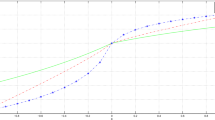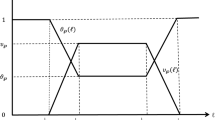Abstract
The selection of appropriate renewable energy sources (RESs) for a region is a complex multi-criteria decision-making problem because the RES selection process involves many factors, such as economic, environmental, technological and societal. Hence, to address this problem, this paper proposes a multistage framework for selecting a suitable RES alternative by integrating picture linguistic fuzzy numbers (PLFNs), preference ranking organization method for enrichment evaluations II (PROMETHEE II) and prospect theory (PT). First, PLFNs are used to describe the evaluation information. Second, using the proposed picture linguistic fuzzy weighed Heronian distance measurement, this paper proposes an extended maximizing deviation method that can capture the interrelationships among criteria. Third, an extended PROMETHEE II, which considers the bounded rationality of decision-makers, combined with PT is developed. Finally, the proposed framework solves a RES selection problem in northwest of China. The result shows solar energy is the best choice, followed by wind, hydro and biomass energy. Sensitivity analysis is conducted to explore the effects of the parameters on the results. The advantages of the proposed method are verified through a comparative analysis.






Similar content being viewed by others
Abbreviations
- \(\rho\), \(\gamma\), \(\kappa\) :
-
Parameters in prospect theory
- \(f\) :
-
Linguistic scale function
- \(d_{g} \left( {p_{1} ,p_{2} } \right)\) :
-
Distance between picture linguistic fuzzy numbers
- \(D = \left( {\delta_{ij} } \right)_{m \times n}\) :
-
Initial evaluation matrix
- \(E_{ij} = \left( {e_{ij} } \right)_{m \times n}\) :
-
Normalized evaluation matrix
- \(Dev_{j}\) :
-
Unweighted deviation of alternatives under criteria \(C_{j}\)
- \(p_{j} \left( {A_{i} ,A_{h} } \right)\) :
-
The degree of alternative \(A_{i}\) is superior to others under criteria \(C_{j}\)
- \(s\), \(t\) :
-
Indifference threshold in the preference function
- PT:
-
Prospect theory
- DM:
-
Decision maker
- PLFSs:
-
Picture linguistic fuzzy sets
- E-MDM:
-
Extended maximizing deviation method
- RES:
-
Renewable energy source
- \(S = \left\{ {\left. {s_{i} } \right|i = 0,2, \ldots ,2t} \right\}\) :
-
Linguistic term set
- \(A_{m} = \left\{ {A_{1} ,A_{2} , \ldots ,A_{m} } \right\}\) :
-
Renewable energy source alternatives
- \(C_{n} = \left\{ {C_{1} ,C_{2} , \ldots ,C_{n} } \right\}\) :
-
Evaluation criteria
- \(\omega_{j} {\kern 1pt} {\kern 1pt} {\kern 1pt} {\kern 1pt}\) :
-
Weight of criteria
- \(R = \left( {r_{j} } \right)_{n}\) :
-
Reference point alternative
- \(V\) :
-
Perceptual distance
- \(P\left( {A_{i} ,A_{h} } \right)\) :
-
Alternative \(A_{i}\) is superior to \(A_{h}\) under all criteria
- \(x\),\(y\) :
-
Parameters in Heronian mean operator
- \(B_{k} = \left\{ {B_{1} ,B_{2} , \ldots ,B_{k} } \right\}\) :
-
Evaluation criteria of experts
- PLFNs:
-
Picture linguistic fuzzy numbers
- PROMETHEE:
-
Preference ranking organization method for enrichment evaluations
- PLFWHD:
-
Picture linguistic fuzzy weighed Heronian distance
- Ref.:
-
Reference
References
Ahmad, S., Nadeem, A., Akhanova, G., Houghton, T., Muhammad-Sukki, F.: Multi-criteria evaluation of renewable and nuclear resources for electricity generation in Kazakhstan. Energy 141, 1880–1891 (2017). https://doi.org/10.1016/j.energy.2017.11.102
Ahmad, S., Tahar, R.M.: Selection of renewable energy sources for sustainable development of electricity generation system using analytic hierarchy process: a case of Malaysia. Renew. Energy 63, 458–466 (2014). https://doi.org/10.1016/j.renene.2013.10.001
Al Garni, H., Kassem, A., Awasthi, A., Komljenovic, D., Al-Haddad, K.: A multicriteria decision making approach for evaluating renewable power generation sources in Saudi Arabia. Sustain. Energy Technol. Assess. 16, 137–150 (2016). https://doi.org/10.1016/j.seta.2016.05.006
Amer, M., Daim, T.U.: Selection of renewable energy technologies for a developing county: a case of Pakistan. Energy Sustain. Dev. 15(4), 420–435 (2011). https://doi.org/10.1016/j.esd.2011.09.001
Andreopoulou, Z., Koliouska, C., Galariotis, E., Zopounidis, C.: Renewable energy sources: using PROMETHEE II for ranking websites to support market opportunities. Technol. Forecast. Soc. Chang. 131, 31–37 (2018). https://doi.org/10.1016/j.techfore.2017.06.007
Aydin, N.Y., Kentel, E., Sebnem Duzgun, H.: GIS-based site selection methodology for hybrid renewable energy systems: a case study from western Turkey. Energy Convers. Manage. 70, 90–106 (2013). https://doi.org/10.1016/j.enconman.2013.02.004
Brans, J.P., Vincke, P.: Note—A preference ranking organisation method. Manage. Sci. 31(6), 647–656 (1985). https://doi.org/10.1287/mnsc.31.6.647
Büyüközkan, G., Güleryüz, S.: Evaluation of Renewable Energy Resources in Turkey using an integrated MCDM approach with linguistic interval fuzzy preference relations. Energy 123, 149–163 (2017). https://doi.org/10.1016/j.energy.2017.01.137
Büyüközkan, G., Karabulut, Y.: Energy project performance evaluation with sustainability perspective. Energy 119, 549–560 (2017). https://doi.org/10.1016/j.energy.2016.12.087
Büyüközkan, G., Karabulut, Y., Güler, M.: Strategic renewable energy source selection for turkey with hesitant fuzzy MCDM method. In: Kahraman, C., Kayakutlu, G. (eds.) Energy management—collective and computational intelligence with theory and applications, pp. 229–250. Springer International Publishing, Cham (2018)
Çelikbilek, Y., Tüysüz, F.: An integrated grey based multi-criteria decision making approach for the evaluation of renewable energy sources. Energy 115, 1246–1258 (2016). https://doi.org/10.1016/j.energy.2016.09.091
Çolak, M., Kaya, İ.: Prioritization of renewable energy alternatives by using an integrated fuzzy MCDM model: a real case application for Turkey. Renew. Sustain. Energy Rev. 80, 840–853 (2017). https://doi.org/10.1016/j.rser.2017.05.194
Haddad, B., Liazid, A., Ferreira, P.: A multi-criteria approach to rank renewables for the Algerian electricity system. Renew. Energy 107, 462–472 (2017). https://doi.org/10.1016/j.renene.2017.01.035
Hu, X., Wang, H., Tang, X.: Cyber-physical control for energy-saving vehicle following with connectivity. IEEE Trans. Industr. Electron. 64(11), 8578–8587 (2017). https://doi.org/10.1109/TIE.2017.2703673
Jian, X., Jin, F.: CNREC: China renewable energy outlook 2018. Int. Financ. 2, 11–14 (2019)
Kahneman, D., Tversky, A.: Prospect theory: an analysis of decision under risk. Econometrica 47(2), 263–291 (1979). https://doi.org/10.1142/9789814417358_0006
Li, Y.Y., Zhang, H.Y., Wang, J.Q.: Linguistic neutrosophic sets and its application to multi-criteria decision-making problems. Int. J. Uncertain. Quantif. 7(2), 135–154 (2017). https://doi.org/10.1615/Int.J.UncertaintyQuantification.2017019627
Liang, R.X., Wang, J.Q., Zhang, H.Y.: Projection-based PROMETHEE methods based on hesitant fuzzy linguistic term sets. Int. J. Fuzzy Syst. 20(7), 2161–2174 (2018). https://doi.org/10.1007/s00521-016-2672-2
Lin, S., Li, C., Xu, F., Liu, D., Liu, J.: Risk identification and analysis for new energy power system in China based on D numbers and decision-making trial and evaluation laboratory (DEMATEL). J. Clean. Prod. 180, 81–96 (2018). https://doi.org/10.1016/j.jclepro.2018.01.153
Liu, G.: Development of a general sustainability indicator for renewable energy systems: a review. Renew. Sustain. Energy Rev. 31, 611–621 (2014). https://doi.org/10.1016/j.rser.2013.12.038
Liu, P., Cheng, S., Zhang, Y.: An extended multi-criteria group decision-making PROMETHEE method based on probability multi-valued neutrosophic sets. Int. J. Fuzzy Syst. 21(2), 388–406 (2019)
Liu, Y., Wang, X., Wang, J., Li, L., Cheng, P.: Cloud model-based PROMETHEE method under 2D uncertain linguistic environment. J. Intell. Fuzzy Syst. (2020). https://doi.org/10.3233/JIFS-191546
Malkawi, S., Al-Nimr, M.D., Azizi, D.: A multi-criteria optimization analysis for Jordan’s energy mix. Energy 127, 680–696 (2017). https://doi.org/10.1016/j.energy.2017.04.015
Nie, R.X., Wang, J.Q.: Prospect theory-based consistency recovery strategies with multiplicative probabilistic linguistic preference relations in managing group decision making. Arab. J. Sci. Eng. 45(3), 2113–2130 (2020). https://doi.org/10.1007/s13369-019-04053-9
Peng, J.J., Tian, C., Zhang, W.Y., Zhang, S., Wang, J.Q.: An integrated multi-criteria decision-making framework for sustainable supplier selection under picture fuzzy environment. Technol. Econ. Devel. Econ. (2020). https://doi.org/10.3846/tede.2020.12110
Phong, P.H., Cuong, B.C.: Multi-criteria group decision making with picture linguistic numbers. J. Sci. Comp. Sci. Com. Eng. 33(3), 39–52 (2016). http://repository.vnu.edu.vn/handle/VNU_123/56914
Pinna-Hernández, M.G., Martínez-Soler, I., Díaz Villanueva, M.J., Acien Fernández, F.G., López, J.L.C.: Selection of biomass supply for a gasification process in a solar thermal hybrid plant for the production of electricity. Ind. Crops Prod. 137, 339–346 (2019). https://doi.org/10.1016/j.indcrop.2019.04.060
Qiao, D., Shen, K., Wang, J., Wang, T.: Multi-criteria PROMETHEE method based on possibility degree with Z-numbers under uncertain linguistic environment. J. Ambient Intell. Human. Comput. 11(5), 2187–2201 (2020). https://doi.org/10.1007/s12652-019-01251-z
Ren, J., Lützen, M.: Selection of sustainable alternative energy source for shipping: multi-criteria decision making under incomplete information. Renew. Sustain. Energy Rev. 74, 1003–1019 (2017). https://doi.org/10.1016/j.rser.2017.03.057
San Cristóbal, J.R.: Multi-criteria decision-making in the selection of a renewable energy project in spain: the VIKOR method. Renew. Energy 36(2), 498–502 (2011). https://doi.org/10.1016/j.renene.2010.07.031
Şengül, Ü., Eren, M., Eslamian Shiraz, S., Gezder, V., Şengül, A.B.: Fuzzy TOPSIS method for ranking renewable energy supply systems in Turkey. Renew. Energy 75, 617–625 (2015). https://doi.org/10.1016/j.renene.2014.10.045
Shen, K., Li, L., Wang, J.: Circular economy model for recycling waste resources under government participation: a case study in industrial waste water circulation in China. Technol. Econ. Dev. Econ. 26(1), 21–47 (2020)
Shen, K.W., Wang, X.K., Qiao, D., Wang, J.Q.: Extended Z-MABAC method based on regret theory and directed distance for regional circular economy development program selection with Z-information. IEEE Trans. Fuzzy Syst. (2019). https://doi.org/10.1109/TFUZZ.2019.2923948
Tian, C., Peng, J., Zhang, W., Zhang, S., Wang, J.: Tourism environmental impact assessment based on improved AHP and picture fuzzy PROMETHEE II methods. Technol. Econ. Dev. Econ. 26(2), 355–378 (2020). https://doi.org/10.3846/tede.2019.11413
Tian, Z.P., Nie, R.X., Wang, J.Q., Luo, H.Y., Li, L.: A prospect theory-based QUALIFLEX for uncertain linguistic Z-number multi-criteria decision-making with unknown weight information. J. Intell. Fuzzy Syst. 38(2), 1775–1787 (2020). https://doi.org/10.3233/JIFS-190065
Tian, Z.P., Wang, J., Wang, J.Q., Zhang, H.Y.: Simplified neutrosophic linguistic multi-criteria group decision-making approach to green product development. Group Decis. Negot. 26(3), 597–627 (2017). https://doi.org/10.1007/s10726-016-9479-5
Troldborg, M., Heslop, S., Hough, R.L.: Assessing the sustainability of renewable energy technologies using multi-criteria analysis: suitability of approach for national-scale assessments and associated uncertainties. Renew. Sustain. Energy Rev. 39, 1173–1184 (2014). https://doi.org/10.1016/j.rser.2014.07.160
Wang, C.C., Davidson, F., Trivedi, S.: Moving space-charge field effects in photoconductive semiconductors with interband optical excitation of free charge carriers. J. Opt. Soc. Am. B 14(1), 21–26 (1997). https://doi.org/10.1364/JOSAB.14.000021
Wang, L., Wang, X.K., Peng, J.J., Wang, J.Q.: The differences in hotel selection among various types of travellers: a comparative analysis with a useful bounded rationality behavioural decision support model. Tour. Manage. 76, 103961 (2020). https://doi.org/10.1016/j.tourman.2019.103961
Wang, L., Zhang, H., Wang, J.Q., Wu, G.F.: Picture fuzzy multi-criteria group decision making method to hotel building energy efficiency retrofit project selection. Oper. Res. 54(1), 211–229 (2020). https://doi.org/10.1051/ro/2019004
Wang, L., Zhang, H.Y., Wang, J.Q., Li, L.: Picture fuzzy normalized projection-based VIKOR method for the risk evaluation of construction project. Appl. Soft Comput. 64, 216–226 (2018)
Wang, Y., Liang, Z., Wu, S., Han, Z., Ren, X.: Idiopathic ventricular arrhythmias originating from the right coronary sinus: prevalence, electrocardiographic and electrophysiological characteristics, and catheter ablation. Heart Rhythm 15(1), 81–89 (2018). https://doi.org/10.1016/j.hrthm.2017.09.008
Xiao, F., Wang, J.: Multistage decision support framework for sites selection of solar power plants with probabilistic linguistic information. J. Clean. Prod. 230, 1396–1409 (2019). https://doi.org/10.1016/j.jclepro.2019.05.138
Xu, J., Wang, X.: Self-healing of concrete cracks by use of bacteria-containing low alkali cementitious material. Constr. Build. Mater. 167, 1–14 (2018). https://doi.org/10.1016/j.conbuildmat.2018.02.020
Ye, X.H.: China renewable energy development report 2017. Water Power 44(12), 23 (2018)
Yu, H., Liu, P., Jin, F.: Research on the stochastic hybrid multi-attribute decision making method based on prospect theory. Scientia Iranica. Transaction E, Industrial Engineering 21(3), 1105–1119 (2014)
Yuan, J., Li, C., Li, W., Liu, D., Li, X.: Linguistic hesitant fuzzy multi-criterion decision-making for renewable energy: a case study in Jilin. J. Clean. Prod. 172, 3201–3214 (2018). https://doi.org/10.1016/j.jclepro.2017.11.038
Zeng, M., Liu, X.M., Li, Y.L., Peng, L.L.: Review of renewable energy investment and financing in China: status, mode, issues and countermeasures. Renew. Sustain. Energy Rev. 31, 23–37 (2014). https://doi.org/10.1016/j.rser.2013.11.026
Zhang, L., Xin, H., Yong, H., Kan, Z.: Renewable energy project performance evaluation using a hybrid multi-criteria decision-making approach: case study in Fujian, China. J. Clean. Prod. 206, 1123–1137 (2019). https://doi.org/10.1016/j.jclepro.2018.09.059
Zhong, L., Yao, L.: An ELECTRE I-based multi-criteria group decision making method with interval type-2 fuzzy numbers and its application to supplier selection. Appl. Soft Comput. 57, 556–576 (2017). https://doi.org/10.1016/j.asoc.2017.04.001
Zhou, H., Wang, J.Q., Zhang, H.Y.: Stochastic multi-criteria decision-making approach based on SMAA-ELECTRE with extended grey numbers. Int. Trans. Operat. Res. 26(5), 2032–2052 (2019). https://doi.org/10.1111/itor.12380
Acknowledgement
The authors are very grateful to the anonymous reviewers for their valuable comments and suggestions to help improve the overall quality of this paper. This work was supported by the National Natural Science Foundation of China (No. 71871228).
Author information
Authors and Affiliations
Corresponding author
Rights and permissions
About this article
Cite this article
Chen, T., Wang, Yt., Wang, Jq. et al. Multistage Decision Framework for the Selection of Renewable Energy Sources Based on Prospect Theory and PROMETHEE. Int. J. Fuzzy Syst. 22, 1535–1551 (2020). https://doi.org/10.1007/s40815-020-00858-1
Received:
Revised:
Accepted:
Published:
Issue Date:
DOI: https://doi.org/10.1007/s40815-020-00858-1




